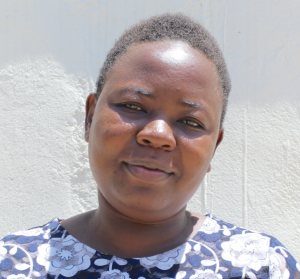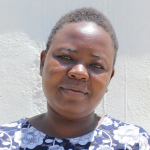May, 2021: Vuyanzi Spring Project Complete!
Litinye Community now has access to clean water! We transformed Vuyanzi Spring into a flowing source of water, thanks to your donation. Our team protected the spring and trained the community on improved sanitation and hygiene practices, including COVID-19 prevention.

Community members pose along the path and stairs to the completed spring.
"Many times, I have been forced to supervise the process of boiling water before my family uses it. Knowing that all the contamination routes have been closed, I will not have stress - I will only boil water if advised to do so," said David Mwembi, the community's pastor who blessed the spring as part of the celebration marking the handing over of the project from our team to the community.

"Since our spring is not seasonal, I am planning to meet with all the youths, especially knowing that they are at home, and see if we can raise some money and buy some vegetable seeds and plant them during this dry season. By the time they resume school, we shall be able to buy ourselves some items needed at school."

Children were just as excited as the adults about the new water point.
"Initially, before our spring was protected, I was afraid to go and get water from the spring during the day; I would prefer late in the evening because of the queue. At the moment, there is no queueing at the spring. Thus no time is wasted. I will be able to draw water any time I feel like it. Apart from that, I will have time to do my revision which will result in a good performance at school," said primary school-aged boy Ezekiel.

Preparing for Spring Protection
Community members worked together to source and carried all locally available construction materials to the spring. These included bricks, sand, stones, and fencing poles. Some people also chiseled away at large stones to break them down into the gravel. Because people have to carry most items by hand, the materials collection process can take anywhere from a few weeks to months.

Community members help deliver construction materials to the spring.
When everything was prepared, we sent a lorry to the community to deliver the rest of the construction materials, including the cement, plastic tarps, and hardware. Then, our artisan and field officers deployed to the spring to begin work. Individual households provided meals throughout each day to sustain the work team.

Delivering rocks to the work site
From Open Source to Protected Spring: A Step-by-Step Process
At last, it was time to dig in at the spring! Women and men lent their strength to the artisan each day to help with the manual labor. First, we cleared and excavated the spring area. We dug a drainage channel below the spring and several surface runoff diversion channels above and around the spring. These help to divert environmental contaminants carried by the rains away from the spring.

Excavation
To ensure community members could still fetch water throughout the construction process, we also dug temporary diversion channels from the spring’s eye around the construction site. This allowed water to flow without severely disrupting community members’ water needs or the construction work.

Setting the foundation
Excavation created space for setting the spring’s foundation made of thick plastic tarp, wire mesh, concrete, and waterproof cement. After setting the base, we started brickwork to build the headwall, wing walls, and stairs.

Bricklaying
Next, we began one of the most crucial spring protection steps to ensure a fully functional water point: setting the discharge pipe. The discharge pipe has to be low enough in the headwall so that the water level inside never rises above the spring’s eye, yet high enough to leave eighteen to twenty inches between the pipe and the spring floor. This allows room for the average jerrycan (a 20-liter container) to sit beneath the pipe without making contact.

Setting up the rub walls and digging the drainage channel
If the discharge pipe were placed too high above the spring’s eye, too much backpressure could force the flow to emerge elsewhere. Too low, and community members would not be able to access the water easily. We embedded the pipe using clay (or mortar when the clay is in short supply) and placed it slightly incline to ensure water flows in the right direction.

Setting the pipe
In coordination with brickwork, we pitched medium to large stones on both sides of the spring’s drainage channel. We then cemented and plastered each stone group into place, forming the rub walls. These help discourage people and animals from standing on that area, which could cause soil erosion and thus a clogged drainage area.

Stairs construction
We turned to cementing and plastering both sides of the headwall and wing walls with brickwork and stone pitching completed. These finishing layers reinforce the brickwork and prevent water in the reservoir from seeping through the walls. In turn, enough pressure builds in the reservoir box to push water out through the discharge pipe.

Plastering
As the headwall and wing walls were curing, we cemented and plastered the stairs and installed four tiles beneath the discharge pipe. The tiles protect the concrete from the falling water’s erosive force while beautifying the spring and facilitating easy cleaning of the spring floor.

Setting the tiles
We transitioned to the final stages of construction with the tiles in place - backfilling the reservoir box. First, we cleared the collection box of any debris that may have fallen in since its construction, such as dead leaves or other items. Then we redirected the temporary diversion channels back into the reservoir box, channeling water into this area for the first time. We closed off all of the other exits to start forcing the water through the discharge pipe only.

Backfilling
With much help from the community, we filled up the reservoir area with the clean and large stones they gathered, arranging them in layers like a well-fitting puzzle. We covered the stones with a thick plastic tarp to minimize potential contamination sources from aboveground, followed by a layer of soil. We piled enough soil on top to create a slight mound to compensate for the backfill’s future settlement.

Fencing
Community members transplanted grass onto the backfilled soil to help prevent erosion. Finally, the collection area was fenced to discourage any person or animal from walking on it since compaction can lead to disturbances in the backfill layers and potentially compromise water quality.

The entire construction process took about two weeks of work and patience to allow the cement and plaster to finish curing. As soon as it was ready, people got the okay from our field officers to fetch water. We officially handed over the spring directly following training to mark the community's ownership of the water point. To mark the occasion, the spring's water user committee chair talked to the pastor, David Mwembi, who prayed before the community members started using the water.

Training on Health, Hygiene, COVID-19, and More
Due to the ongoing challenges and restrictions amidst the pandemic, we worked with local leaders and the national Ministry of Health to gain approval for a small group training about health, hygiene, and COVID-19 prevention.
Together with the community, we found their preferred date for training while considering other community calendar events, such as the agricultural and social events. We requested a representative group of community members to attend training to relay the information learned to the rest of their family and friends.

Physical distancing check
When the day arrived, facilitator, Betty Muhongo, deployed to the site to lead the event. 23 people attended the training, including community-based leaders. We held the training under a tree close to the spring. There was enough space, and the breeze was cool, thus making the environment conducive for the training.

Onsite training about spring maintenance while spring was underway
Perhaps the most crucial topic of the day was our session on COVID-19 prevention and control. Due to the rampant spread of misinformation about COVID-19, we dedicated time to a question and answer session to help debunk rumors about the virus and provide extra information where needed.

Practicing using the elbow for safer coughs and sneezes.
We covered several other topics, including community participation in the project; leadership and governance; personal and environmental hygiene; water handling and treatment; operation and maintenance of the spring; dental hygiene; the ten steps of handwashing, and how to make and use a tippy tap and leaky tin. We held an election for the newly formed water user committee leaders during the leadership and governance session.

Trainer Betty demonstrates the ten steps of handwashing.
We also brainstormed income-generating activities that can be used to start community savings account for any future minor repairs to the spring and a cooperative lending group to enable members to develop small businesses.
Handwashing became the most memorable topic. One of the participants said that the Coronavirus could only be prevented by using either sanitizer or liquid soap, citing a common myth in Kenya about the effectiveness of bar soap, which is cheaper and more common than liquid soap. Facilitator Betty took the opportunity to explain the myth, emphasizing that all soaps work equally well in handwashing. They are actually preferable to hand sanitizer, addressing another common myth here.

A community member demonstrates handwashing.
"The training has been informative to me because I had very little knowledge on sanitation matters. Now I can put into practice what I have learned, and my life will not be the same again," said Esther Wanyonyi, a farmer and the elected Treasurer of the Water User Committee.
"The training has been very important to me. Initially, I would put on my mask only after I had seen a teacher. After the training, I learned it was for my own good and not for the teacher's rules. With the knowledge I have gotten from this training, I am not worried about COVID-19. I will always wear my mask whenever I go out," said Dancan, a primary school-aged student in the community.

"Mask-wearing was the most helpful part of the COVID-19 sensitization training. I wear my mask like a necklace so that whenever I saw a teacher, I could pull it up. I no longer do that because I know the importance of wearing the mask the correct way," Dancan continued.
"Apart from wearing my mask well, I will continue encouraging other people to avoid overly crowded places. I think if we all adhere to the rules and regulations put in place by the Ministry of Health, we will be able to fight the virus, and within a concise period, our country will be a Corona-free zone," he added.

When an issue arises concerning the water project, the water user committee is equipped with the necessary skills to rectify the problem and ensure the water point works appropriately. However, if the issue is beyond their capabilities, they can contact our field officers to assist them. Also, we will continue to offer them unmatchable support as a part of our ongoing monitoring and maintenance program.
Thank you for making all of this possible!


 Protected Spring
Protected Spring
 Rehabilitation Project
Rehabilitation Project














































